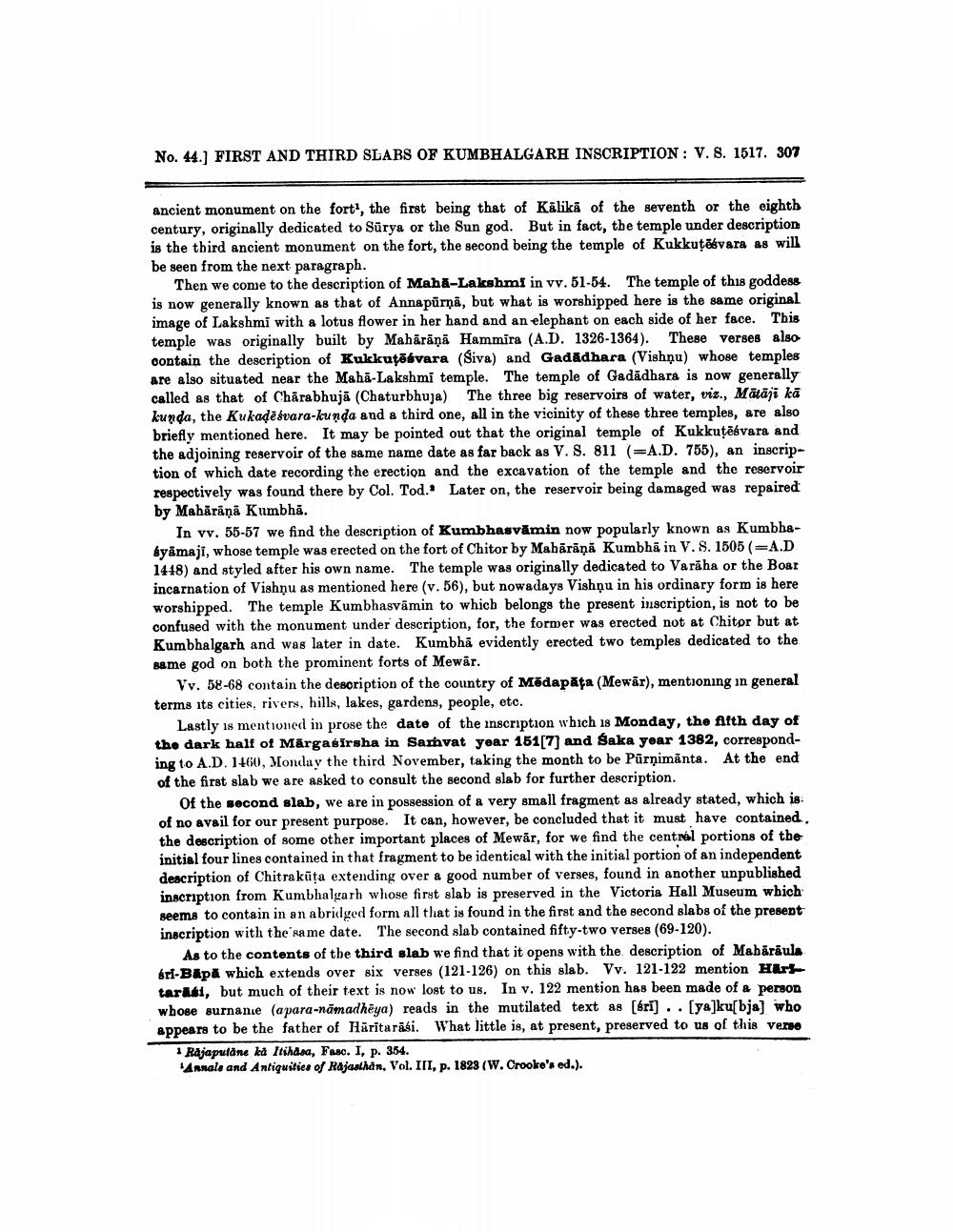________________
No. 44.] FIRST AND THIRD SLABS OF KUMBHALGARH INSCRIPTION: V. S. 1517. 307
ancient monument on the fort, the first being that of Kalika of the seventh or the eighth century, originally dedicated to Surya or the Sun god. But in fact, the temple under description is the third ancient monument on the fort, the second being the temple of Kukkutaévara as will be seen from the next paragraph.
Then we come to the description of Maha-Lakshmi in vv. 51-54. The temple of this goddess is now generally known as that of Annapurna, but what is worshipped here is the same original image of Lakshmi with a lotus flower in her hand and an elephant on each side of her face. This temple was originally built by Mahārānā Hammira (A.D. 1326-1364). These verses also contain the description of Kukkutē vara (Siva) and Gadadhara (Vishnu) whose temples are also situated near the Maha-Lakshmi temple. The temple of Gadadhara is now generally called as that of Charabhuja (Chaturbhuja) The three big reservoirs of water, viz., Mātāji kā kunda, the Kukadēśvara-kunda and a third one, all in the vicinity of these three temples, are also briefly mentioned here. It may be pointed out that the original temple of Kukkutēévara and the adjoining reservoir of the same name date as far back as V. S. 811 (=A.D. 755), an inscription of which date recording the erection and the excavation of the temple and the reservoir respectively was found there by Col. Tod. Later on, the reservoir being damaged was repaired by Mahārānā Kumbha.
In vv. 55-57 we find the description of Kumbhasvamin now popularly known as Kumbhasyamaji, whose temple was erected on the fort of Chitor by Mahārāņa Kumbha in V. S. 1505 (=A.D 1448) and styled after his own name. The temple was originally dedicated to Varaha or the Boar incarnation of Vishņu as mentioned here (v. 56), but nowadays Vishnu in his ordinary form is here worshipped. The temple Kumbhasvamin to which belongs the present inscription, is not to be confused with the monument under description, for, the former was erected not at Chitor but at Kumbhalgarh and was later in date. Kumbha evidently erected two temples dedicated to the same god on both the prominent forts of Mewar.
Vv. 58-68 contain the description of the country of Medapăţa (Mewar), mentioning in general terms its cities, rivers, hills, lakes, gardens, people, etc.
Lastly is mentioned in prose the date of the inscription which is Monday, the fifth day of the dark half of Märgasirsha in Samvat year 151[7] and Saka year 1382, corresponding to A.D. 1460, Monday the third November, taking the month to be Pürņimanta. At the end of the first slab we are asked to consult the second slab for further description.
Of the second slab, we are in possession of a very small fragment as already stated, which is of no avail for our present purpose. It can, however, be concluded that it must have contained. the description of some other important places of Mewar, for we find the central portions of the initial four lines contained in that fragment to be identical with the initial portion of an independent description of Chitrakuța extending over a good number of verses, found in another unpublished inscription from Kumbhalgarh whose first slab is preserved in the Victoria Hall Museum which seems to contain in an abridged form all that is found in the first and the second slabs of the present inscription with the same date. The second slab contained fifty-two verses (69-120).
As to the contents of the third slab we find that it opens with the description of Mahāraula éri-Bapa which extends over six verses (121-126) on this slab. Vv. 121-122 mention Hari tarasi, but much of their text is now lost to us. In v. 122 mention has been made of a person whose surname (apara-namadheya) reads in the mutilated text as [éri].. [ya]ku[bja] who appears to be the father of Häritarasi. What little is, at present, preserved to us of this verse
1 Rajapulane ka Itihasa, Fasc. I, p. 354.
Annals and Antiquities of Rajasthan, Vol. III, p. 1823 (W. Crooke's ed.).




